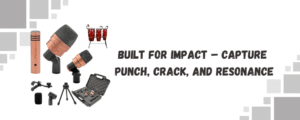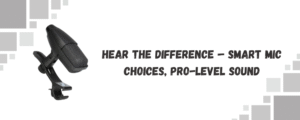Whether you’re building a home studio or refining your live rig, choosing the right drum mics can be the difference between a lifeless thud and a punchy, dynamic sound that holds up in any mix. With so many options out there, it’s easy to fall into the trap of overspending—or worse, buying the wrong mics altogether.
This drum microphone guide breaks down what you really need, what to look for, and how to find the best mics for drums without blowing your budget.
The Basics: Understand Your Drum Kit’s Needs
Not all drums are created equal—and neither are the mics you use to capture them. Each part of the kit has different frequency content, volume, and resonance. That means your snare, toms, kick, and overheads each call for a different mic type or voicing.
Start by identifying your priorities:
- Recording or live use?
- Full kit or just a few key pieces?
- Natural tone or processed punch?
Once you know your goals, you can build your setup mic by mic—or go for a bundled solution if you need it all at once.
Kick Drum: Go Big or Go Muffled
The kick is the heartbeat of your kit. You want something that can handle high SPL and still capture low-end weight and midrange punch.
Look for dynamic mics with a tailored low-frequency response. You don’t need anything fancy—just something tough, directional, and capable of focusing on the low end. Many stage-proven models keep it simple with cardioid patterns and high SPL ratings.
If you’re building out your kit piece by piece, a kick-specific mic is a must. But if you want a pre-matched set, the 5 Core Conga & Snare/Tom Condenser Mic Set includes well-tuned options for a variety of drums, including lower-frequency instruments like floor toms and kick drums.
Snare Drum: Detail and Crack
The snare needs to cut through—but not pierce. Look for a mic that balances attack and warmth. Again, a dynamic cardioid mic does the job here. Positioning matters just as much as the mic itself, but a solid build with tight off-axis rejection goes a long way in keeping hi-hat bleed under control.
For hybrid setups, a condenser mic with focused response—like those included in the 5 Core condenser kit—can also add subtle air and definition without sounding harsh.
Toms: Punch and Resonance
Toms need to feel alive—especially in recordings. You’re looking for mics that can handle fast transients and preserve body. You don’t want boxy, flat tones.
Clip-on dynamic mics are the standard here, as they’re easier to position and built for close-miking. Some condenser models can work great too—especially for floor toms—if your room is controlled.
This budget-friendly option provides enough isolation and SPL handling to record toms cleanly, even in untreated spaces.
Overheads: The Big Picture
Overheads capture the cymbals, but also the overall image of your kit. Go with small diaphragm condensers if you’re after crisp detail and stereo imaging. If you prefer more room and ambiance, large diaphragm options work too.
You don’t need to spend a fortune—just make sure the mics are matched and have solid sensitivity ratings.
That said, if you’re working with limited inputs, your overheads might carry most of the tonal weight. In that case, spend a bit more here than you would on individual drum mics. Some hybrid sets even include smaller condenser options, like those found in this compact drum mic kit built for compact overhead work.
Hi-Hats & Cymbals: Optional but Useful
If your overheads are dialed in, you might not need a dedicated hi-hat mic. But if your hats are doing complex rhythmic work, a small diaphragm condenser can help highlight those patterns without oversaturating the high end.
Use it sparingly and angle it away from the snare. You want detail, not splashy harshness.
Room Mic: Optional Luxury
Room mics are great for ambience, but only if your room sounds good. If you’re working in a tight or untreated space, skip it.
However, if you’ve got decent acoustics, a single LDC (Large Diaphragm Condenser) placed a few feet from the kit can give you that roomy, live feel—especially useful for rock, jazz, or ambient recordings.
Buying Strategy: Full Kit vs. Individual Mics
If you’re starting from scratch, going with a kit like the 5 Core Condenser Mic Set can be smart. These bundles usually include everything you need—kick, snare, toms, and sometimes overheads—all pre-matched to work together.
On the other hand, if you’re upgrading piece by piece, start with the kick and snare mics. These two have the biggest impact on your mix. Add tom mics next, then overheads.
Final Word
Finding the right drum mics isn’t about chasing brand names or specs—it’s about knowing what your setup needs and choosing accordingly. Whether you’re hunting for the perfect tom mic, refining your overheads, or building from scratch, the key is matching the mic to the role.
Start simple. Listen often. And let your ears—not your gear list—be the final judge.




